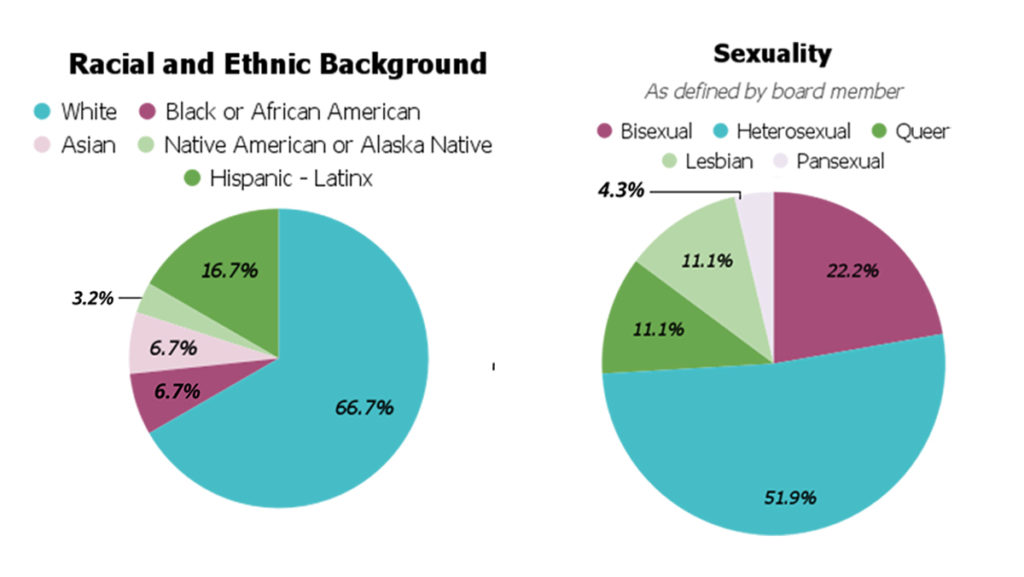In late August, The Ithacan’s editorial board received a short survey designed by the community outreach manager which asked for demographic information with the intent to collect information for what would become the paper’s first diversity report. A report of this kind is used to quantify the diverse makeup of an organization. It can also highlight a lack of diversity and inspire goals to address inclusion in the workplace.
The survey consisted of seven questions. Some were answered by multiple choice and others were open-ended. While the responses remain anonymous, the findings were charted and compared with available Ithaca College student population data. All 26 of the current editorial board members completed the survey.
Before publication, the results of this report were available internally and used for reflection during The Ithacan’s diversity training workshop Oct. 8, led by the Center for Inclusion Diversity Equity and Social Change (IDEAS) peer educators. The focus of the workshop was on implicit biases, which are unconscious stereotypes or attitudes that can manifest in our behavior and society. The findings of this report were available as a tool to help understand how implicit biases have effect in a newsroom.
While the workshop was available only to editorial board members, The Ithacan plans to implement future sessions open to all staff and mandate attendance to peer education workshops held by the Center for IDEAS in the future. While the paper has made conscious efforts to report inclusively and unbiasedly, there has never been a formal process in place to ensure the newsroom is actively working to do so.
This diversity report serves as a benchmark for future use as The Ithacan sets a standard of transparent reporting of the makeup of its newsroom. As a paper designed to represent student voices, it is important that there is a sustainable effort encouraging representation on the editorial board and equitable coverage of all student populations. The Ithacan recognizes that it has not completed a diversity report before, and is actively working to remedy past indiscretions.
By preparing and publishing a diversity report for the end of the fall semester, the paper is working to hold itself accountable in its goal to create a more inclusive publication. Given that this survey is the first of its kind, it may not be all-encompassing. A public forum where members of the campus community will be able to have an open conversation to discuss the findings and give feedback on improving the report in the future will be held Jan. 31, 2022.
Racial and Ethnic Background
In accordance with the U.S. Census Bureau’s standard of collecting racial and ethnic background data, this survey question had six multiple choice options. The Ithacan editorial board is predominantly white. While there was no mixed–race option, this survey question allowed for multiple answers.
The findings show that no one on The Ithacan board is Alaskan Native or Pacific Islander. Black, Indigenous and persons of color (BIPOC) on The Ithacan’s board represented 33.4% of the newsroom. This is 10.1% higher than the BIPOC population at Ithaca College. Population data for the campus is located under the Office of Analytics and Institutional Research (AIR) on the college’s website. Its data classification is different, as the college includes international populations. While the survey did not have an international option, there are no international students on The Ithacan’s editorial board.
For comparison, Ithaca College students are 72.4% white, 5.4% Black or African American, 10% Hispanic/Latino, 3.9% Asian, 0.1% Native American/Alaskan Native, 0.1% Native Hawaiian or Pacific Islander, 3.8% two or more races, 1.8% unknown and 2.4% international. There are 5,239 total Ithaca College students.
Gender
The Ithacan board is predominantly composed of cisgender women with cisgender women making up 73.9%. The student body of Ithaca College is reported as being 56.7% women and 43.3% men. Nonbinary representation on the editorial board is low, at 4.3% and transgender representation is nonexistent. The AIR does not report the number of nonbinary or transgender students at the college.
Sexuality
This survey question was not multiple choice and each board member wrote their answer in a text box. This means the categories for sexuality data are specific to how the board member completing the form identifies. The majority of the board identified as heterosexual while 22.2% identified as bisexual, 11.1% queer, 11.1% lesbian and one individual identified as pansexual. For this and the following categories, there is no readily available data to compare with the college’s student body. However, the college has been consistently ranked as the “Best of the Best” on the Campus Pride index since 2012.
Class Year
The majority of the editorial board is upperclassmen with 46.2% being juniors, 38.5% seniors and 15.4% sophomores. The editorial board for the fall semester is hired during the previous spring semester so there were no incoming freshmen on campus, and therefore, they are not represented on the editorial board.
First Generation
According to the college’s website, 15% of the student body is first-generation students. First-generation is defined as having parents who did not complete or begin a four-year degree in higher education. While the college’s data has not been updated for the 2021–22 academic year, it is clear the editorial board needs improvements in order to reach a higher level of first-generation representation as it currently has only two board members who are first-gen.
Major
The majority of board members have majors in the Roy H. Park School of Communications. Four members, or 15.4% of the board, have a major in the School of Humanities and Sciences. The Ithacan is currently looking for ways to recruit students from other schools.
Ability
Like other categories, there is no publicly available data to compare the larger student body with The Ithacan’s board. However, 95.7% of the editorial board is able-bodied.







